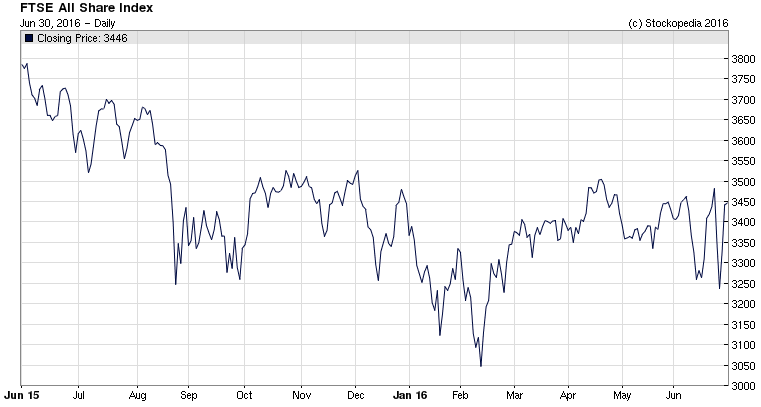Stockopedia’s 60 Guru Strategies inspired by legends of finance endured a rollercoaster end to the second quarter of 2016. There have been reasonable results from some of the methodologies, but on average it has been a disappointing quarter for them. And things got a whole lot worse in the final week of the first-half as the EU referendum result threw equities into chaos.
The UK’s decision to leave the EU caused instant volatility in parts of the market. It cast a particularly dark shadow over cyclical stocks with any hint of reliance on European trade or domestic consumer confidence. Some of the biggest losers were banks, builders, retailers, recruiters and airlines. On the flip-side, defensive stocks (especially those blue-chips that earn a good chunk of profits from foreign markets) fared a lot better.
London’s main indices all fell sharply straight after the referendum. But as investors absorbed the news, there were areas of improvement. How the UK economy will be affected by the decision over the longer term is uncertain, but that hasn’t stopped the FTSE 100 recovering lost ground and reaching new highs for 2016. That was driven by a number of global corporations which effectively benefit from a lower valuation of sterling and are less reliant on the domestic economy.

By association, the FTSE All Share (above), which is a cap weighted index representing the FTSE 100, 250 and SmallCap, shows very little amiss bar some recent sharp price swings. This is partly down to heavy weighting of large cap stocks in the index. Out of 636 constituents in the index, the top 10 on a market-cap basis represent nearly 31.8% of it. A better guide to the impact on domestic stocks is the FTSE 250 mid-cap index. But even here, some of the sharp immediate losses have been clawed back, albeit at a slower pace.
How the guru strategies performed
Before taking a look at how the guru strategies got on in Q2, it’s worth having a quick recap on how they work and what the performance stats tell us. Since late 2011, we’ve been tracking the returns from a range of approaches used by some of the world’s best known investors. Each one is categorised as either Quality, Growth, Value, Bargain, Income or Momentum. They’re rebalanced quarterly to ensure that the the shares in each portfolio…








